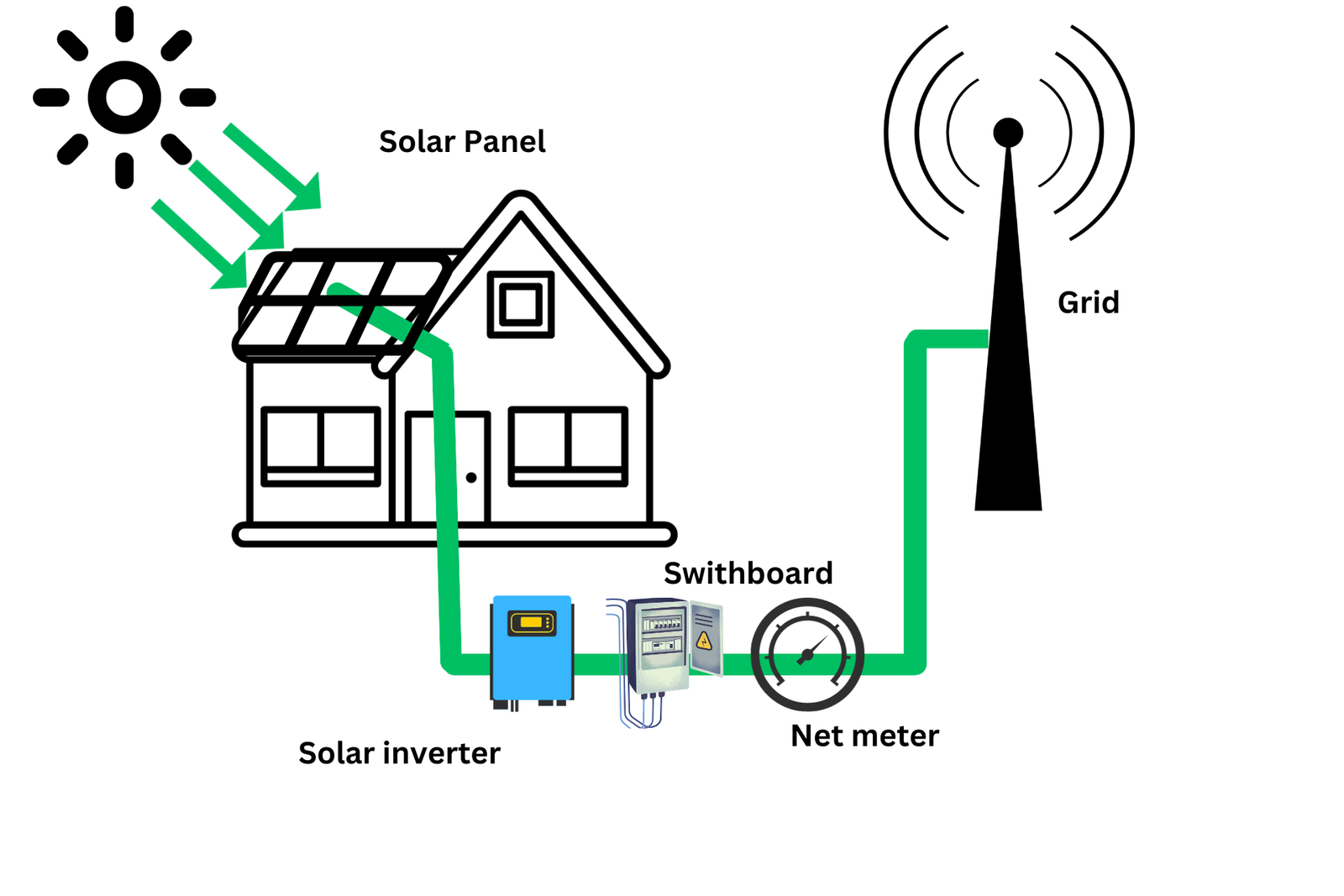Unlock the mysteries behind solar panels in our comprehensive guide on “How Does a Solar Panel Work?” Solar panels, often hailed as the heroes of sustainable energy, have become a common sight on rooftops and in solar farms. But have you ever wondered how these sleek panels actually harness the power of the sun and transform it into electricity? Let’s dive into the fascinating world of solar energy.
Introduction of How Does a Solar Panel Work?
In an era where sustainable energy sources are becoming increasingly vital, solar power stands out as a beacon of hope. At the heart of this eco-friendly revolution lies the solar panel, a technological marvel that transforms sunlight into electricity. But how does a solar panel work? Let’s embark on a journey into the intricate world of photovoltaic cells and harnessing the power of the sun.
The Basics of Solar Panels
Solar panels are composed of photovoltaic cells, the building blocks responsible for converting sunlight into electricity. These cells are typically made from silicon, a semiconductor material that plays a crucial role in the photovoltaic process. When sunlight strikes these cells, it triggers a series of events that ultimately generate an electric current.
The Photovoltaic Process
Photon Absorption: It all begins with the sun releasing photons, tiny packets of energy that travel through space. When these photons reach the Earth and strike a solar panel, they interact with the silicon atoms in the photovoltaic cells.

Electron Liberation: The interaction causes electrons in the silicon atoms to become energized and break free from their normal positions. This process creates electron-hole pairs, where the electron is free to move, leaving behind a positively charged “hole.”
Electric Field Generation: The presence of these free-moving electrons and positive holes creates an electric field within the solar cell. This electric field acts as a force that drives the liberated electrons toward the front surface of the cell and the holes toward the back.
Electron Flow and Current Generation: As the electrons move toward the front surface, they form an electric current. This flow of electrons is what we harness as electricity. By placing metal contacts on the front and back of the solar cell, we create a circuit through which the generated electric current can be drawn.
Electricity for Consumption: The electric current produced by the solar panel can now be used to power electrical devices, stored in batteries for later use, or fed into the electrical grid to contribute to the overall energy supply.
The Inverter’s Role
The inverter is a crucial component in the solar power system, responsible for converting the DC produced by the solar panels into the AC used in our households. Its intelligence lies in its ability to synchronize with the grid frequency, ensuring a seamless integration of solar-generated electricity with the existing power supply. Without the inverter’s conversion prowess, the energy harvested from the sun would remain inaccessible for most applications.
Types of Solar Panels
There are different types of solar panels, each with its unique characteristics and applications. The three main types are monocrystalline, polycrystalline, and thin-film solar panels.
Monocrystalline Solar Panels: These panels are made from a single crystal structure, offering high efficiency and a sleek black appearance. Monocrystalline panels are known for their space efficiency and long lifespan.
Polycrystalline Solar Panels: Constructed from multiple silicon crystals, polycrystalline panels are cost-effective and easier to manufacture. While slightly less efficient than monocrystalline panels, they remain a popular choice for residential and commercial applications.
Thin-Film Solar Panels: Thin-film panels use layers of semiconductor materials deposited on a supporting material like glass or metal. They are lightweight and flexible, allowing for diverse applications such as solar tiles and integrated solar solutions.
Net Metering and Beyond
One of the revolutionary aspects of solar power is the concept of net metering. When your solar panels generate more electricity than your home consumes, the excess is fed back into the grid. In return, you receive credits on your electricity bill. This not only promotes energy self-sufficiency but also transforms solar panel owners into contributors to the broader energy ecosystem.
Sun-Kissed Efficiency: Factors Influencing Solar Panel Performance
Tilt and Orientation: Maximizing Sun Exposure
The angle and direction of solar panels significantly impact their efficiency. Proper tilt and orientation ensure optimal exposure to sunlight, enhancing energy production.
Weather Matters: Solar Panels in Overcast Conditions
Contrary to popular belief, solar panels can still generate power on cloudy days. While output may decrease, the panels continue to harness diffuse sunlight, maintaining a degree of functionality.
Maintenance and Cleaning: Prolonging Solar Panel Lifespan
Regular cleaning and maintenance are vital to ensure the longevity of solar panels. Dirt and debris can hinder sunlight absorption, affecting overall performance.
Applications of Solar Panels
The versatility of solar panels extends far beyond traditional photovoltaic arrays. Their applications are diverse and continually expanding, contributing to the development of sustainable energy solutions.
Residential Solar Power Systems: Homeowners can install solar panels on rooftops to generate electricity for their homes. This not only reduces dependence on the grid but can also lead to significant cost savings over time.
Commercial and Industrial Installations: Businesses and industries are increasingly adopting solar power to meet their energy needs. Large-scale solar installations can power factories, offices, and other commercial spaces, contributing to both cost savings and environmental sustainability.
Off-Grid Power Solutions: In remote areas or during emergencies, solar panels paired with energy storage systems provide a reliable off-grid power source. This is particularly valuable in regions with unreliable access to traditional energy sources.
Solar-Powered Transportation: The integration of solar panels in transportation is evolving, with solar-powered cars and bicycles becoming more prevalent. These vehicles utilize solar panels to generate electricity and reduce reliance on traditional fuels.
Solar Water Heating Systems: Beyond electricity generation, solar energy can also be harnessed for water heating. Solar water heating systems use the sun’s energy to heat water for residential and commercial use, offering an energy-efficient alternative to traditional water heaters.
Challenges and Innovations
While solar power has made significant strides, it faces challenges that researchers and engineers are actively addressing through innovative solutions.
Efficiency Improvement: Enhancing the efficiency of solar panels remains a priority. Researchers are exploring advanced materials and design modifications to maximize the capture and conversion of sunlight into electricity.
Energy Storage: The intermittent nature of sunlight poses a challenge for consistent energy supply. Energy storage solutions, such as improved batteries, are critical for storing excess energy generated during sunny periods for use during cloudy days or nighttime.
Environmental Impact of Production: The manufacturing process of solar panels involves the use of materials that can have environmental consequences. Sustainable manufacturing practices and recycling initiatives are being developed to minimize the environmental footprint of solar technology.
Cost Reduction: While the cost of solar panels has decreased over the years, further reductions are essential to make solar power more accessible globally. Ongoing research focuses on finding cost-effective materials and manufacturing processes.
Conclusion
As we stand at the crossroads of environmental challenges and the quest for sustainable energy, solar panels emerge as a beacon of promise. Understanding how solar panels work unveils the elegance of harnessing the sun’s energy to power our homes, businesses, and even our modes of transportation. With ongoing innovations and a collective commitment to a greener future, solar power is set to play an increasingly pivotal role in our quest for a sustainable and energy-efficient world.







